#nadeko medusa
Text
fumodeko

18 notes
·
View notes
Photo

a medusa nadeko sketch I decided to make look less sketchy
#nadeko sengoku#nadeko medusa#I love nadeko so much my murderous daughter#I still have to finish monogatari series but I hope araragi listens to kaiki and doesn't bother her anymore :\#speaking of which do we get anymore kaiki and nadeko moments I liked their dynamic a whole lot#kaiki and his adoptive snake daughter
74 notes
·
View notes
Text

unfinished drawing !
53 notes
·
View notes
Text

Next, Nadeko Medusa 🐍
#nadeko sengoku#nadeko medusa#my art#monogatari#bakemonogatari#otorimonogatari#koimonogatari#glad she got mental help
14 notes
·
View notes
Text

Today's Daily Degurechaff is… Tanya Circulation
#dailydegurechaff#youjo senki#the saga of tanya the evil#tanya von degurechaff#so i do occasionally give the blogs that follow dailydegu a cursory glance to make sure theyre not bots right#and something ive noticed a few times now#is that ive seen multiple people who just. wholeheartedly adore nadeko sengoku#its not a lot but its weird i keep noticing it#i didnt realize there was an overlap in “Nadeko Appreciators” and “Tanya Appreciators”#anyway this one goes out to the nadeko girlies. nadeko medusa was one of my favorite monogatari arcs
98 notes
·
View notes
Photo

"I get to take the person I love, and totally k*ll him!"
-- Nadeko Sengoku
Done for Month of Love 2020
#fan art#anime#bakemonogatari#nadeko sengoku#sengoku nadeko#nadeko snake#month of love#MoL#red#white#snakes#medusa#cats cradle#blood#i just like how she went full yandere ok#illustration#artists on tumblr
67 notes
·
View notes
Text
read otorimonogatari and i. i can't believe how blatantly gay nadeko is in the novel. it's insane.
#i'm going to chew through my pillow what the fuck#btw there's so much going on with this little freak that nadeko medusa (anime) doesn't even begin to address
3 notes
·
View notes
Note
is nadeko sengoku better at playing touhou with our without the snakes
With the snakes but only because Kaiki drags a pc up to shirahebi shrine every day and teaches her to beat EOSD on lunatic mode (cant leave it there or shed break it)
12 notes
·
View notes
Text










#off season#monster season#anime#we finally won#its hard to believe#im so happy#monogatari anime#monogatari#nadeko sengoku#sengoku nadeko#nadeko medusa? more like nadeko mebooza amirite *canned laughter*
1 note
·
View note
Text
I don’t know what happened, I listened to one presentation about the rising popularity of figure collecting even though the prices have gotten whack and now I’m looking to buy figures again.
I wanna get Akari who I skipped out on originally since I thought she’d be too plain for my collection, but now I want to be comforted by her gentle presence. She went from being 10k to 25k-30k though, and I don’t want to spend that much on anime plastic.
It’s the same for all the figures I’m interested in. Somewhat fortunately also for a lot of the figures I ended up getting while I was collecting actively 5-8 years ago. Seems like it’s still true today that you had to start collecting “a few years earlier” while everything was cheaper and specific preorders were still available.
#my nonsense#figures#the most annoying part is that i chose not to buy her for less than 10k on amiami when she was first released#same with nadeko medusa#altho for her it was also logistics and me being broke after my exchange
1 note
·
View note
Text
all omori mono icons i made so far ◉‿◉ i wanna draw boss nadeko/kuchinawa/medusa sprite nexttt
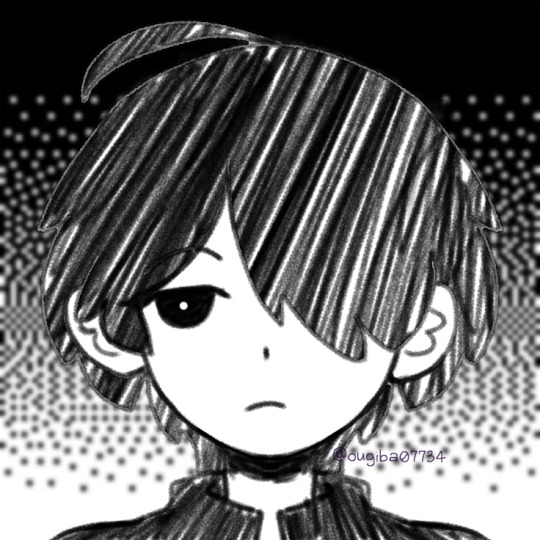

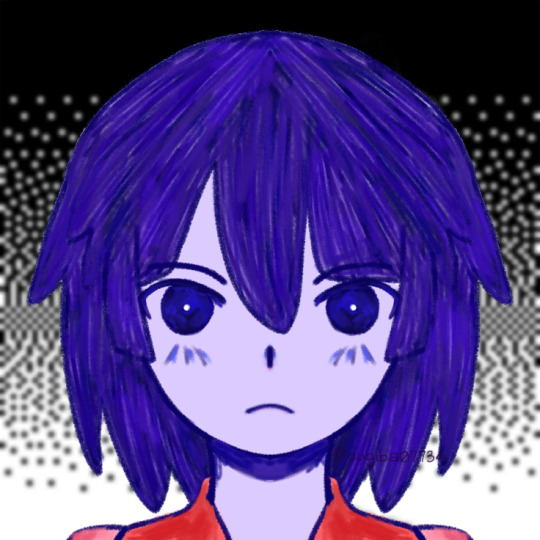
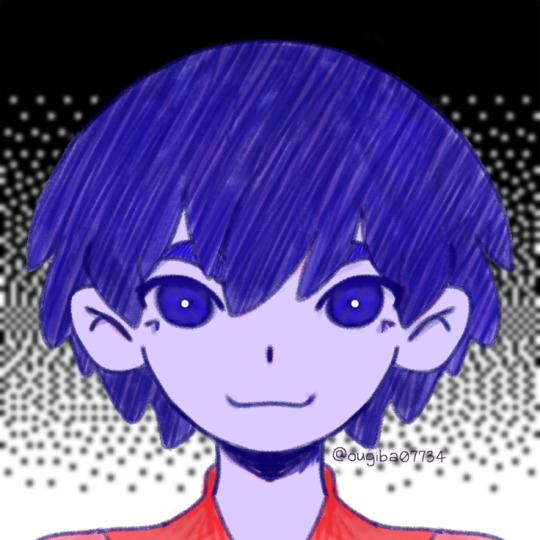
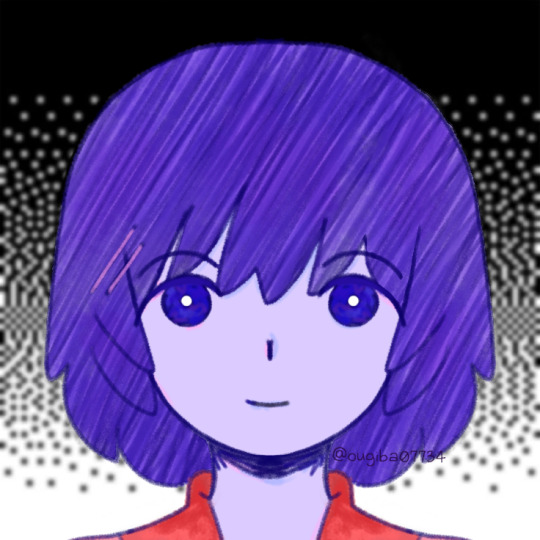
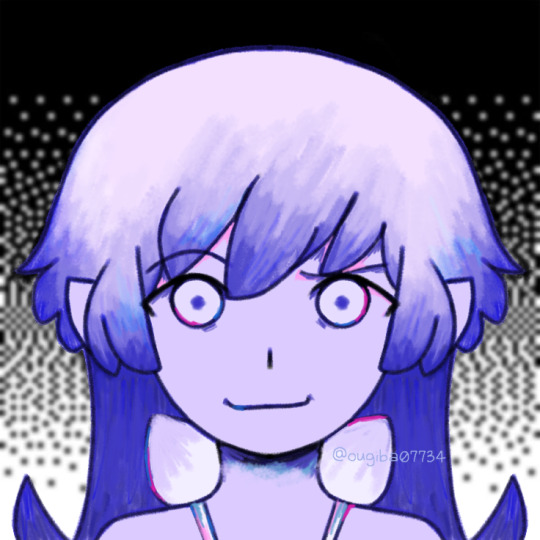
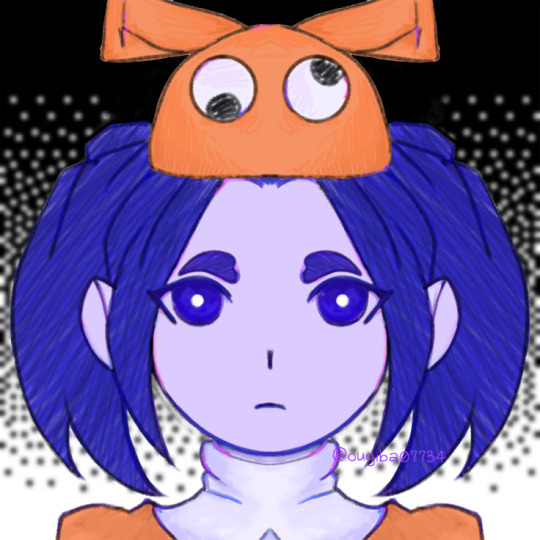
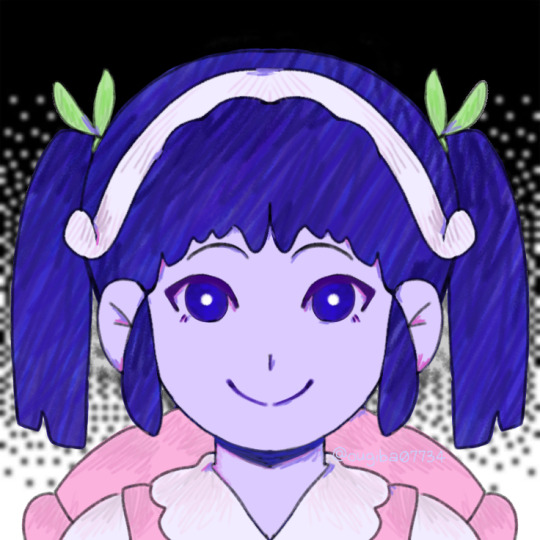
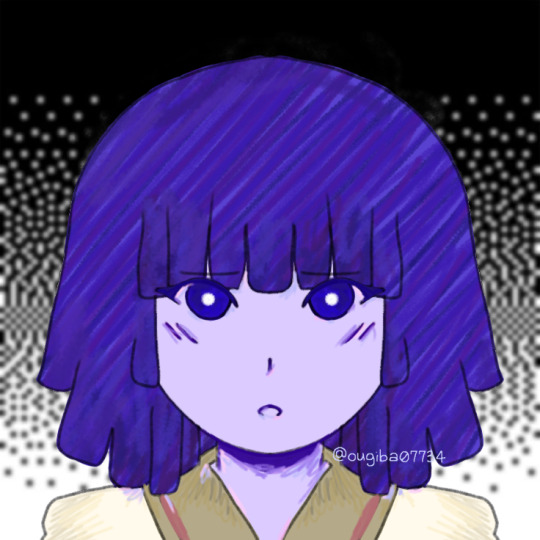
#monogatari series#my art#monogatari#oshino ougi#araragi koyomi#nadeko sengoku#shinobu oshino#oshino shinobu#hanekawa tsubasa#hitagi senjougahara#mayoi hachikuji#yotsugi ononoki#suruga kanbaru#omori#edit the hachikuji pic was Messed up for some reason#ougi :)
161 notes
·
View notes
Text
Nadeko Medusa - An Analysis
Otorimonogatari begins in media res, with the emphasis on the inevitability of this ending solidifying it as a kind of tragedy. Why am I here, Nadeko asks. Why me? Why was this so inevitable?
What did the rest of the cast do that allowed for their problems to be solved, that allowed for Koyomi to help them instead of becoming enemies?
In truth we’re well off the rails - Nadeko doesn’t even have the typical specialist appearance that so consistently helps in every other arc. The one that unravels the mysteries is the serpent, Kuchinawa, who turns out to be none other than Nadeko herself.
In other words the specialist role is filled by Nadeko, the protagonist role is filled by Nadeko, the victim role is filled by Nadeko, even the oddity afflicting her - all Nadeko. It’s an entirely solipsistic, fabricated story.
As a result, Koyomi’s involvement becomes singularly unhelpful. I don’t know if people really do just go ahead and save themselves, but at the very least they have to try to let others save them. There’s a particular poison about Nadeko that makes Koyomi’s usual modus operandi, seen from the outside, particularly useless. We see in his interactions with her throughout the arc that he suspects she is the victim of an oddity despite her denials - Nadeko thinks she is lying to him, but Koyomi’s guesses are already completely off from the perspective of Nadeko herself being the snake. He doesn’t think of her as someone capable of manipulating and deceiving, as someone capable of being the instigator of her own incident.
Koyomi’s partial immortality is a representation of his self-sacrificing nature, him lowering his ‘intensity as a human’ in order to better approach others. But the more he lowers his guard around Nadeko the worse it gets, her poison stopping him from healing.
Poison is a topic that comes up in the previous arc, the motto of Gaen Tooe, Kanbaru Suruga’s mother. “If you can’t be medicine, then be poison, otherwise you’re just plain old water.” What she means by poison is also ambiguous. It does bring to mind the antagonist of that arc (if you can even call her that) Numachi Rouka. Rouka, a girl that Koyomi couldn’t save, couldn’t even meet. Nadeko and Rouka have one main similarity - a tendency to run away from their problems & avoid getting to know other people.
When something is asked of her Nadeko’s typical response is to do nothing, neither refuse or accept but simply wait until they give up, papering the interaction over with various ‘sorry’s or ‘anyway’s to avoid addressing the main topic. Nadeko is barely aware of what she herself is doing throughout much of the arc, avoiding thinking about the problems instead of doing anything to address them - like asking for help. After she snaps in the classroom, she leaves - after eating the talisman in Koyomi’s house, she runs away - no destination in mind besides getting away from the questions and expectations placed on her by society.
Nadeko’s depression and anxiety, just like Rouka before her, alienate her from life itself - embracing inhuman death in the form of becoming an oddity.
One of the things about oddities is that they don’t appear to ordinary people. Hachikuji calls it the ‘backstage’ in Nisemonogatari. They’re cut off from the ordinary operations of the world itself, only visible to those with supernatural connections or their own chosen victims.
And Nadeko, by the end of Otorimonogatari, is quite firmly an oddity, a creature that can’t be approached for no reason.
Koyomi saw the Lost Cow because he was lost. In encountering the Curse Cat he was, in fact, cursed. He has no business with the god of a dead shrine. No doors to unlock, no prayers to grant, no story to tell.
The narrative no longer sees him as trying to help a friend, but rather trying to forcibly involve himself with an oddity, in the same way as he wrestled the jagirinawa in Nadeko Snake. Don’t mistake the person you’re trying to save, Suruga tells him then. Nadeko is no longer the person he’s trying to save, now.
This leads me to believe the point where it’s officially Nadekover is when she takes the talisman, fuses with Kuchinawa, loses her last reason to be attached to the narrative of herself as a human. The framing of the novel presents it as an inevitable ending because it’s narrated from the perspective of a Nadeko who’s already reached that ending. For her, looking back, there’s no changing the sequence of events that led her there. The idea that everything happening to her is inevitable and beyond her control is a neat excuse for her, but it’s not true.
Okay, but seriously, how did we get here?
Nadeko constantly interprets events in a way that makes her feel guilty, like she did something wrong. Her fundamental view of the world revolves around “victimisers and victims” (i.e. people who hurt others and people who are hurt).

She would rather see herself as a bystander, as someone who doesn’t interact with others in either way. She finds the idea of human interaction, human touch, to be uncomfortable. However, people tend to see her as a victim, leading to an increasing worry about having a victim complex, thinking of it as ‘tricking’ others into seeing her as a victim, which becomes, in the extreme, victimising them in itself.

She dissociates as a coping mechanism, seeing what she does and what is done to her as if it was happening to someone else. “Nadeko” did it, not her. “Nadeko” is how other people see her. An important part of Nadeko’s image is her bangs, which help craft an image of her in others’ minds, by obscuring her eyes and how she truly feels. This serves a kind of contradictory purpose, as while it’s implied Nadeko chose the bangs to deflect from her cuteness (even wearing baggy and unfeminine clothing as much as possible to avoid emphasising her cuteness) the bangs still result in people seeing her as cute. They can’t see the real her, and substitute their own assumptions onto her.

While this has some upsides for Nadeko, as it allows her to retain a blameless image, it also results in a lack of an identity. Nadeko knows who “Nadeko” is, but not who she is. She doesn’t truly identify with any of the things she does, so they’re attributed to “Nadeko”, not her. When others compliment her for being cute, she doesn’t feel as though she is being complimented. She doesn’t feel cute. She feels like she’s tricking people into thinking she’s cute. This constructed Nadeko allows her to feel like a bystander, the very thing she desires to soothe her guilt, but the more she feels as though she’s deliberately constructing it the more guilt she feels over the ‘deception’.
Tsukihi is a kind of anti-Nadeko. Someone motivated with a strong sense of identity. Someone who’s direct to a fault and uncomplicatedly happy when people find her cute. Someone who doesn’t ascribe to Nadeko’s victimiser/victim dichotomy, because she believes in a third role, the hero. Someone who can touch others without making them uncomfortable, put in effort that doesn’t just help themself.
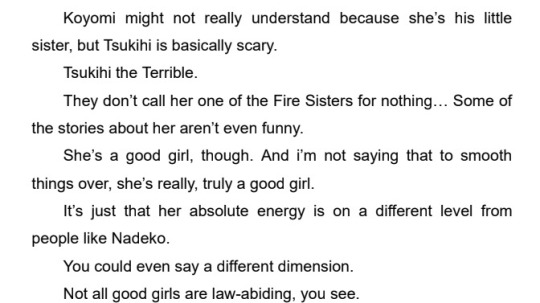
Nadeko fears and loves her in equal measure. Fears her, because her attention is one of the few things capable of breaking through Nadeko’s shield of indifference. Loves her, because she’s exactly the kind of person Nadeko wants to be but thinks she never could.
Trying to deal with Tsukihi reveals some of the contradictions inherent to Nadeko’s attitude. She acts passively, in a way that encourages people to be sympathetic, but then professes to be upset by getting that sympathy. Tsukihi, on the other hand, gives Nadeko just as much sympathy as she thinks Nadeko deserves, and Nadeko craves more nonetheless. In some ways she does still want to ‘look cute’ to others and relies on the acceptance that comes along with it. She’s stuck in a weird Catch-22 where she cant get closer to or further away from other people without resenting herself even more.

It’s suggested that Nadeko’s crush on Koyomi is originally sourced from Tsukihi. It makes sense that Nadeko would pick Koyomi as a more conventional target for her affections, thinking the closest she could get to Tsukihi was a kind of sister-in-law relationship.
Koyomi is someone that she supposedly feels love for, but is that coming from “Nadeko” or herself? The problem is that it’s not love exactly, it’s just another kind of shield that performs a similar role to her bangs. It gives her an excuse for why she isn’t interested in romance. It allows her to present as ‘normal’ to others, but of course that perception of normality belongs to “Nadeko”, not to her. Even Koyomi himself can’t get through to her. She doesn’t want him to understand her, to break down the barriers between them, she wants to keep him away with the bangs, to look cute to him just as she does to everyone else. She doesn’t actually want Koyomi, she just wants to remain in a constant state of wanting him, an unobtainable dream.

Cracks start emerging because of Hitagi’s presence, and that’s what has Nadeko praying for divine intervention. Hitagi makes the story of her loving Koyomi more trouble than it’s worth. It introduces jealousy, the business of dealing with his lovers. The real way to keep it stable isn’t even to kill Hitagi, it’s to kill him, affix him in the heavens as an unchanging star that will never grow any further or any closer.
It’s tempting to see this particular purpose as the reason why Kuchinawa, as an oddity, descends upon Nadeko. But Nadeko herself doesn’t want to think about it. It’s not like Tsubasa, who after casting away her memories & emotions is genuinely unaware of them. Nadeko feels guilty about her curses towards Hitagi, wants to look cute by not mentioning them. The role that Kuchinawa fills isn’t to get Nadeko on a beeline to the talisman - he works much more indirectly.
First, and most obviously, Kuchinawa is a bully. He speaks rudely and directly where Nadeko is quiet and demure. This isn’t a shift in alignment, Kuchinawa isn’t ‘bad girl’ Nadeko - he just says what she’s been thinking this whole time and doesn’t want to admit to. His comments when he goes into school with her all question the ‘point’ of what she’s doing. From one view it’s an ancient god questioning new concepts, from another it’s Nadeko finally allowing herself to question things that she’s had to quietly accept this whole time. The intrusive thoughts stop her from concentrating and eventually lead to her snapping and fully channeling Kuchinawa to talk to the rest of the class. Again, while we could see this as Kuchinawa’s “influence”, it makes much more sense that Nadeko herself can no longer hold her feelings back.

After all, another role that Kuchinawa’s directness performs is allowing Nadeko to poke at her own insecurities and contradictions. Kuchinawa is the voice in her head pointing out all the things that Nadeko has done wrong, ensuring the sources of her guilt are never far from her mind. There’s an odd kind of comfort to it, though - unlike the criticisms of other people, Kuchinawa never expects anything from her in response. He is amused by Nadeko’s deceptions, not resentful. He sees everyone in the world as a victimiser, as a liar. Everyone lives while deceiving themselves and others. It’s only natural. Therefore there’s nothing Nadeko can do about it. No way of her remaining a bystander.

Ultimately what I think Kuchinawa represents is Nadeko’s creative impulse turned towards escapism. He allows her to construct a story, present her life in a way she can accept, participate in a narrative she chooses. Her love for Koyomi is a story she’s been telling for a while, one that allows her to paper over the cracks in her life and give her the strength to continue. Now cracks start emerging in that story, and to paper them over she reaches for a paper-thin talisman.

The question arises of why Kuchinawa (why Nadeko) even needed it in the first place. Clearly it plays a role in feeding Nadeko’s fantasies, granting Kuchinawa the supernatural power he needs to become real. But despite being billed as capable of granting any wish, it can’t actually make the story of her love for Koyomi real. It can’t make him love her. Because she doesn’t want him to in the first place.
No, the talisman’s powers are limited. It can’t truly turn back time, or erase her mistakes at school, because she doesn’t believe her actions could ever be changed. It’s been over from the start, Nadeko says. There’s only one way it could ever end for her, only one type of person she could ever be, only one choice she could ever make.
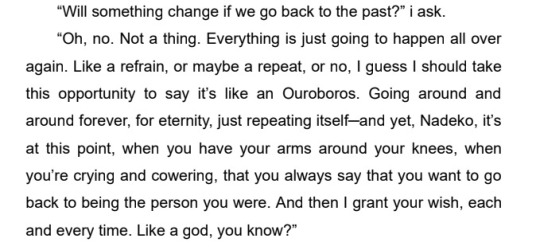
Every other Monogatari character has had multiple choices. Take Koyomi, who was prompted to kill the monster entirely, and instead made it one with him. Suruga, who was encouraged by Rouka to leave her alone and just live a normal life, and instead came back to play a final game. Tsubasa could have just let the oddities in her mind go burn off her stress and pretend it had nothing to do with her, but instead decided to let them back inside.
Let alone two options, though, Nadeko fails to see even one. What she ends up pursuing is neither of the two options, but instead the bad end, as if Koyomi had remained a vampire with Kiss-Shot.

She refuses to face reality. That’s what Tsukihi says - “telling someone to dream is like telling them to face reality.” It feels a bit contradictory but it fits into a theme that’s been consistent over the last few arcs. Seeing a dream is like having an end goal to work towards. Ougi says in Mayoi Jiangshi that it’s better to not achieve your dreams, because they’ll be inevitably disappointing. Koyomi says in Suruga Devil that wishing for something in itself is fine, it’s a destructive focus on the end result that’s the issue with the Monkey’s Paw. Tsukihi says she would support Nadeko if she was really trying to date Koyomi, but she’s not. She can’t face the reality of Koyomi having a girlfriend, of Koyomi being out of reach for her. What she���s doing is acting as though she’s in a different reality where that’s not true.

It’s a fitting followup that when Nadeko snaps, acting her most Tsukihi-like, it’s to tell the rest of her class to face reality. As a result of Kaiki’s charms the class has started acting, in her words, “just like Nadeko”. Because lots of people’s secret feelings about each other were revealed, they no longer trust each other, assuming everyone around them are trying to trick each other, trying to act cute, to the point where they’ve given up on trying to make close relationships. Given up on the year, the class, entirely. Because they think they have no choice.
Nadeko tells them to face reality, to accept that the world and the people around you aren’t as pretty as the stories we tell about them. To pursue a dream where everyone makes up in the end. To ‘rewrite’ the memory of that class with their own effort. It’s a vision of a Nadeko who does try to address her issues, as embodied by the class and the effects of Kaiki’s talismans. It’s what Otorimonogatari really should have been about, if Nadeko didn’t go ahead and make up another story on her own. A fantastical decoy of a story that has her running out of the classroom and never seeing the result of her efforts.
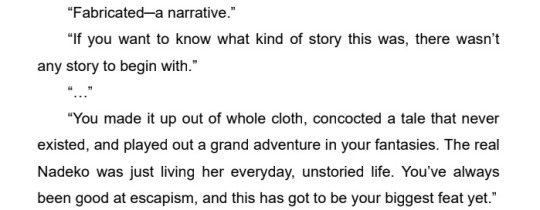
Kaiki’s talismans, if we remember, were fake, their effects not genuinely manifested for anyone but Nadeko, who bought into the story, went as far as to research her own methods of breaking the curse, and ended up making it worse. It’s not as if she was at fault for what happened, it’s not as if she did it on purpose, but it’s hard to shake the feeling that it happened according to her desires. It let her reconnect with Koyomi, didn’t it?
Nadeko is the type of person who can take something false and through her creative impulse, chuunibyou, escapist fantasies, whatever you want to call it, make it into reality. It’s just that she’s unconsciously biased in a destructive direction, one that results in either her being hurt or her hurting others.
This culminates in her consuming the talisman and becoming a god. The story she’s actually trying to make real isn’t the world where she’s an eternal victim, Koyomi constantly looking out for her. It’s the story where she’s an eternal victimizer, a serpent god with sharp fangs.

Due to her new heat vision, her hair isn’t an inconvenience to her any longer, just to others. It pushes them away actively instead of just concealing her. You could say the hundreds of snakes move independently of her will, but in another view they are her will itself, animal instinct embodied. They’re only uncontrollable in the sense that she can’t control her own violent impulses. It’s easier for her to get rid of people than deal with them directly, and this confirms her view of herself as fundamentally selfish. She can’t be like Tsukihi.
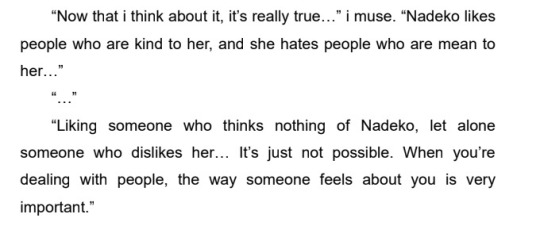
In a complete inversion from the ethos she espouses to her class, Nadeko says she’s someone who likes people only if they’re kind to her, and can’t like anyone who dislikes her. It’s a story where in becoming an oddity she no longer has to deal directly with the human world, no longer has to be concerned with what’s going on with her classroom or her parents.

But that, she says, is “Nadeko”, not me. At the end of it all what she’s doing is still a performance for the benefit of others. She still can’t tell what she really wants, really is. She still gets by with the excuse that she’s a bystander and there’s someone else doing all that stuff. The phone call at the end makes her dissociation clear, I think. If she really wanted to kill Hitagi and Koyomi and Shinobu, would something so simple really stop her? If she actually hated and was jealous of Hitagi, would she calmly listen to her? Does she really have to thank her for her advice? The way she reminds herself that people who are kind to Nadeko are good people sounds like she’s trying to convince herself.
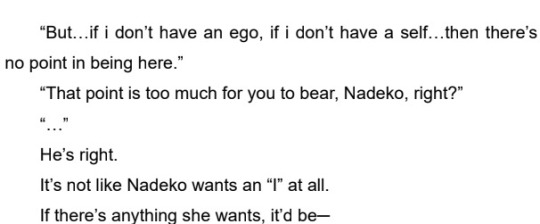
Becoming the serpent god is in line with how Nadeko sees herself, but it’s not what she actually wants. She doesn’t really want an “I”, she tells Kuchinawa as they discuss her lack of self. She just can’t bear existing without one. She says it from the start of the book. She doesn't actually want to defeat Koyomi and reign victorious over the shrine. Nadeko’s way out of this whole mess was for him to kill her.
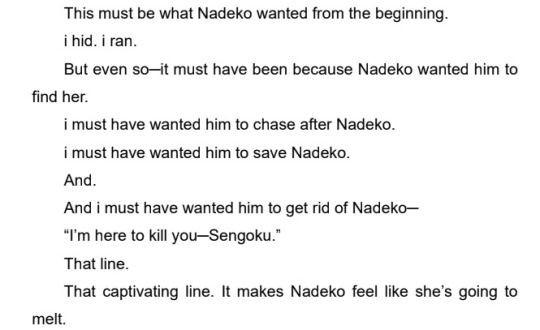
I get it, Nadeko, I really do. Living is just so tiring, after all.

44 notes
·
View notes
Text

happy new years!! _(:3 」∠)_ ☆☆
i was too lazy for the hands………….sorry
45 notes
·
View notes
Text

Nadeko medusa
19 notes
·
View notes
Text
Nadeko's narration is quite different in Nadeko Draw to Nadeko Medusa, and it's hard to tell if that's her shaking off certain immaturities from back then, or if it's just the different translator.
6 notes
·
View notes
